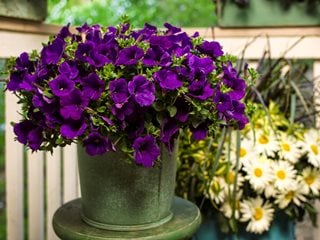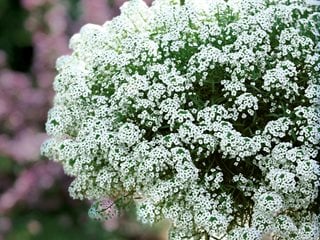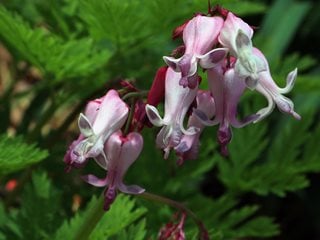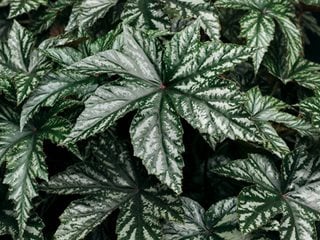Understanding the Difference Between Annual and Perennial Plants
An overview of each plant type and the reasons why both play essential roles in every garden.
Supertunia® Royal Velvet® petunia (annual). Photo by: Proven Winners.
All flowering plants follow the same basic steps in their life cycle. Annuals complete that cycle in one growing season, whereas perennials live on for three years or longer. But, if you begin studying the labels on your new plant or seed packet purchases, you’ll discover many twists on this basic definition. You’ll come across terms such as “hardy" and “half-hardy" annual, or tender perennial. Plus there’s a third plant category, biennials, that combines some of the characteristics of both plant types.
What is clear when comparing annuals and perennials is that neither is superior to the other. Integrating both types into your garden designs (along with shrubs and trees) gives you the best of both worlds and unlimited options in color, texture, form, and bloom time.
WHAT IS AN ANNUAL?
True annuals are plants that germinate, flower, set seed, and die all in one season. Their ultimate goal is to reproduce themselves (set seed), which is good news for gardeners because most annuals will flower like mad until their mission is accomplished. And, if you use methods such as deadheading to prevent seed formation, many annuals will amp up their flower production and continue to bloom profusely until the first frost arrives. Although you'll need to replant most annuals the following spring to get a repeat performance, some will readily self-sow and return for an encore, such as sweet alyssum, bachelor’s button, and forget-me-nots.

Snow Princess® Sweet Alyssum (annual). Photo by: Proven Winners.
Types of Annuals
Not all annuals are equal. They are typically subdivided into three groups:
- Hardy or cool-season annuals, such as forget-me-not and larkspur, thrive in the cool to moderate temperatures of early spring and fall and can tolerate exposure to light frost without being protected.
- Tender or warm-season annuals, such as marigolds and petunias, are native to tropical or subtropical climates and require heat to grow and thrive, often growing poorly during cold weather. To ensure their survival, it’s best to wait until late spring to add these plants to your garden beds or containers.
- Half-hardy annuals are most common and fall in the middle-of-the-road. They tolerate a wide range of temperatures, including periods of cooler weather near the beginning or end of the gardening season.
Why choose annuals?
- Growing annuals can be a great way to take gardening one year at a time; experiment with new plants and color schemes without making a long-term commitment.
- Annuals are perfect for temporarily filling in bare spots in established gardens or refreshing containers through the season.
- Add annuals to a vegetable garden for a splash of color, to fill in gaps when early-season crops are harvested, and attract pollinators to increase production of edible crops.
- Annuals provide nearly instant gratification, maturing faster than perennials or biennials, and often bloom from planting time until frost, and in some cases beyond.
- If you want a lot of blooms, annuals are the answer. They put all of their energy into developing flowers.
Learn more about growing annuals.
Shop annuals online from Proven Winners

Dicentra 'Luxuriant' fern-leaved bleeding heart. (long-blooming perennial). Photo by AppletonOnfoot / Pixabay.
WHAT IS A PERENNIAL?
Unlike their short-lived counterparts, perennials are typically cold-hardy plants that will return again in the spring. They usually bloom for only one season each year (either spring, summer, or fall), but there are also reblooming and long-blooming perennials, such as fern-leaved bleeding heart (Dicentra ‘Luxuriant’).
When grown in favorable conditions, perennials often live a long time, but don’t assume they will last forever. Their life span is variable, and some may live for only three to five years. Perennials also vary greatly in terms of their care and maintenance. Some may need to be pruned and divided regularly to maintain their vigor and keep them tidy, while others are tough and undemanding, seeming to thrive on neglect.
Why choose perennials?
- Although perennials tend to cost more initially, they are a good long-term investment because they return year after year.
- Even perennials that don’t have a long life span can often be propagated by division* or reseeding to perpetuate their population.
- Most perennials require less water once established, which can be especially advantageous for those who garden in drought-prone areas and want to reduce their water consumption.
- Planting perennials that are native to your region offers the additional benefit of creating a welcome habitat for pollinators and local wildlife.
Biennials
Don’t confuse perennials with biennials, such as dianthus, foxglove, and hollyhock. These plants take two years to complete their growth cycle before dying. Usually biennials do not bloom until their second year, but some behave like short-lived perennials and will flower their first year when planted early enough in spring or started indoors in winter.
Learn more about growing perennials.
Shop perennials online from Proven Winners
HOW THEY COMPARE
| HARDY ANNUALS | HALF-HARDY AND TENDER ANNUALS | PERENNIALS | |
|---|---|---|---|
| WHEN TO PLANT |
Spring or early fall. Seeds can be sown in winter in some climates. |
Any time from late spring to midsummer, as long as there is little danger of frost. |
Spring or early fall is best. It is difficult for plants to become established during the heat of the summer. |
| LIFE SPAN |
Typically one growing season, although they may self-sow and return for a second season. |
One growing season. |
Three or more years. |
| COLD HARDINESS |
Cold-tolerant; can handle a slight freeze. |
Intolerant of freezing temperatures. |
Varies, but most plants can survive cold winters. |
| BEST ASSETS |
They thrive early and late in the season, when temperatures are too cool for most tender annuals. |
A great addition to containers or a garden full of perennials, adding nearly instant color when perennials have stopped blooming for the season. |
Provide a sense of continuity from year to year. Although they typically bloom for just a few weeks, their foliage and form contribute to the beauty of the garden throughout the year. |

Pegasus® Begonia hybrid (tender perennial). Photo by: Proven Winners.
PLANTS THAT BREAK THE RULES
Not all flowering plants fall neatly into the categories of annual, perennial, or biennial. Here are a few that break the rules.
Tulips: Although most bulbs are considered to be perennials, tulips are often an exception. Native to Central Asia, they require cold winters and hot, dry summers to return each year. But in climates that don’t offer these conditions, they don’t rebloom reliably and are often treated as annuals.
Tender perennials: You may be surprised to discover that some of the most popular annuals may actually perform as perennials in certain regions of the country. These tender perennials, sometimes called “temperennials," are winter hardy in warmer growing zones but not in northern gardens, where they are typically grown as annuals or even houseplants. Many succulents and tropical plants fit into this category, such as begonias, Alternanthera, elephant ears, and agave.
“If you get right down to it, the label given the plant isn't important. What is important is how the plant performs in your garden," says Proven Winners’ horticulturist Kerry Meyer. “For some of you, the plants we call annuals might actually be perennial. To learn if the ‘annual’ you are looking at is an annual for you, you need to compare the plant’s hardiness zone to the zone in which you garden."
*Note: Make sure you check plant labels before propagating, because propagation (cuttings, division, or grafting) of trademarked plants is prohibited.
RELATED READING:Annuals You’ll Love
Perennials You’ll Love
Winter Annuals
